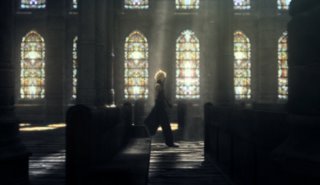I'm finding that instead of being put off by movie versions of books, lately I'm being so inspired by them that I go out and find the book immediately after watching the movie - just so that I can read for myself all of the details that I know have been left out of (or botched up in) the screen play.
Anyways, Middlemarch was excellent. Extremely long, but excellent. It took me almost two and a half weeks to get through the entire thing - I think it was about 7 hours long! Which was annoying (damn those movie late fees!) but wonderful - to have something that good not be over in an hour. Happiness is a British miniseries!
(And chocolate - one cannot forget chocolate.)
There's a quote at the very end of the Middlemarch series that gave me tingles and the cinematography of the scene is beautiful itself, too.* So when Colin came home from the studio, there I was, scribbling it down into my notebook with the close-captioning on. I'm not even certain its a direct quote from the book; guess I'll find out when I start reading it...
"And Dorothea..._____________________________
She had no dreams of being praised above other women, feeling that there was always something better which she might have done, if only she had been better, and known better.
Her full nature spent itself in deeds which left no great name on the earth, but the effect of her being on those around her was incalculable.
For the growing good of the world is partly dependent on unhistoric acts, and on all of those Dorotheas who live faithfully their hidden lives, and rest in unvisited tombs."
George Eliot's MIDDLEMARCH
*And when I Googled it, I was led to this discussion group of mostly women who gathered to discuss what the movie and book meant to them.... back in 1997.
I know its just a small insignificant page, but when I stumble onto some neat-little-coincidence-of-a-site like that I'm struck again by how amazing and cool this crazy thing called the Internet really is. Especially a site where it feels like you've come across... well, footprints in the sand as it were: you can see people were gathered there once, where they are now no one knows, but cyber traces of them remain - their words have taken on a strange kind of immortality.



